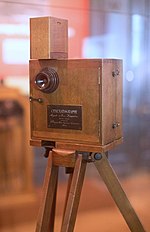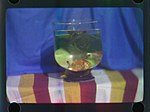Kinemacolor was the first successful colour motion picture process. Used commercially from 1909 to 1915, it was invented by George Albert Smith in 1906...
27 KB (1,904 words) - 17:03, 30 July 2024
Charles Urban (section Kinemacolor)
with this film or with the Kinemacolor Company of America once he had sold the American rights to the process to the Kinemacolor Company of America. Urban's...
14 KB (1,604 words) - 11:03, 30 September 2024
The Kinemacolor Company of America was an American company founded in 1910 by Gilbert H. Aymar and James K. Bowen. It distributed and produced films made...
10 KB (1,066 words) - 10:13, 30 June 2024
1906 had developed a simplified version that he later named Kinemacolor. The Kinemacolor camera had red and green filters in the apertures of its rotating...
94 KB (11,987 words) - 21:24, 11 November 2024
and produced films in Kinemacolor, the first successful colour motion picture process. In March 1909, to capitalise on Kinemacolor, which had first been...
9 KB (826 words) - 08:32, 19 September 2024
mechanically impractical. A simplified two-color version, introduced as Kinemacolor in 1909, was successful until 1915, but the special projector it required...
74 KB (614 words) - 23:52, 3 November 2024
(1912) is a British documentary film. The film is silent and made in the Kinemacolor additive color process. The film records the 12 December 1911 celebrations...
9 KB (935 words) - 19:37, 13 September 2024
simplified additive system was successfully commercialized in 1909 as Kinemacolor. These early systems used black-and-white film to photograph and project...
45 KB (6,203 words) - 20:22, 5 November 2024
Procession organized by Alice Paul. The event was filmed in Kinemacolor by the Kinemacolor Company of America. Presidency of Woodrow Wilson Second inauguration...
4 KB (309 words) - 02:38, 8 November 2024
silent and made in black-and-white with some colour sequences in the Kinemacolor additive color process. The film documents Britain's military preparedness...
9 KB (989 words) - 02:12, 5 September 2024
Seaside (1908) was one of the first successful motion pictures filmed in Kinemacolor. It is an 8-minute short film directed by George Albert Smith of Brighton...
2 KB (122 words) - 18:16, 29 October 2024
Gowland Fred Burns Charles King In 1911, the Kinemacolor Company of America produced a lost film in Kinemacolor titled The Clansman. It was filmed in the...
120 KB (14,319 words) - 02:49, 11 November 2024
(Process 5). Process 4 was the second major color process, after Britain's Kinemacolor (used between 1909 and 1915), and the most widely used color process...
57 KB (7,298 words) - 20:24, 11 November 2024
documentary With Our King and Queen Through India (1912), filmed in Kinemacolor and Oliver Twist (also 1912). The first American features were Oliver...
17 KB (1,845 words) - 22:39, 6 November 2024
close-ups, and his development of the first successful colour film process, Kinemacolor. Smith was born in Cripplegate, London in 1864. His father Charles Smith...
14 KB (1,750 words) - 04:34, 5 September 2024
Bucharest chapter of Pathé. Early color motion picture processes such as Kinemacolor (known for the feature With Our King and Queen Through India (1912))...
59 KB (7,277 words) - 23:55, 4 November 2024
short) as herself La Tosca (1911 short) How to Live 100 Years (1913 Kinemacolor short) as herself Popular Players Off the Stage (1913 short documentary)...
29 KB (3,422 words) - 10:19, 20 July 2024
2 October 1937) was a British film company executive. She funded the Kinemacolor business established by her husband Charles Urban, helping it achieve...
6 KB (762 words) - 17:03, 16 November 2023
considered a lost film,[citation needed] it was made using the additive color Kinemacolor process. The title comes from the Litany in the 1662 Book of Common Prayer:...
4 KB (313 words) - 19:17, 30 December 2023
model was used in early color processes for films from 1906 to 1929 (Kinemacolor, Prizma, Technicolor, Brewster Color, Kodachrome I and Raycol). The additive...
12 KB (925 words) - 10:51, 30 October 2024
cels. The 1939 film The Wizard of Oz was not the first film in color. Kinemacolor was used starting in 1902, and the first Technicolor process debuted...
570 KB (54,705 words) - 20:15, 14 November 2024
defunct in 1914 after they lost the patent for the Kinemacolor process in a lawsuit. Consequently, Kinemacolor lost its commercial value. Arvidson's estranged...
8 KB (917 words) - 10:40, 17 February 2024
the first commercially successful color photography product. 1908 – Kinemacolor, a two-color process known as the first commercial "natural color" system...
30 KB (3,158 words) - 21:24, 11 October 2024
black-and-white photographs. The launch was filmed both in black and white and in Kinemacolor, with only the black and white footage surviving. The launches of Titanic...
82 KB (9,157 words) - 00:25, 5 November 2024
and since 1905 there was a mechanized stencil-process (Pathécolor). Kinemacolor, the first commercially successful cinematographic colour process, produced...
154 KB (18,874 words) - 21:26, 11 November 2024
George Albert Smith developed the first colour film process, known as Kinemacolor, in 1906 at Southwick, West Sussex. George E. Davis from Slough, is the...
180 KB (17,492 words) - 18:04, 14 November 2024
(1998). "Kinemacolor: The First Successful Color System". Widescreen Museum. Retrieved July 8, 2006. Hart, Martin (May 20, 2004). "Kinemacolor to Eastmancolor:...
64 KB (7,991 words) - 23:32, 12 November 2024
hand coloring, but also with fairly natural two-color processes such as Kinemacolor and Technicolor. Traditional colorization processes ceased with the adoption...
78 KB (8,745 words) - 19:10, 14 November 2024
1914, with the 1913 film being made with an early color two-process, Kinemacolor. A version was filmed for Australian TV in 1964. Another well-known version...
16 KB (1,784 words) - 19:23, 1 November 2024
common. Created in 1913 for use in early color film processes such as Kinemacolor, panchromatic was first used in a black-and-white film for exterior sequences...
27 KB (3,759 words) - 00:15, 9 September 2024


















